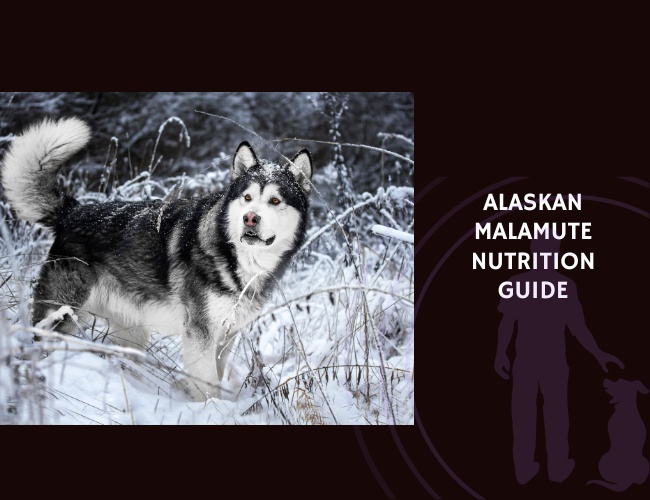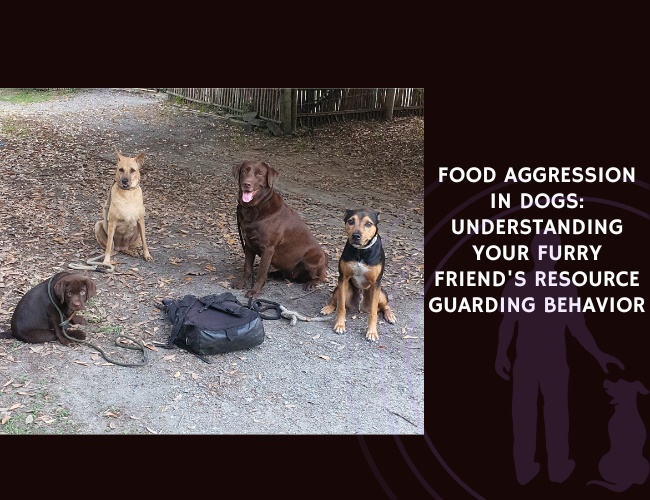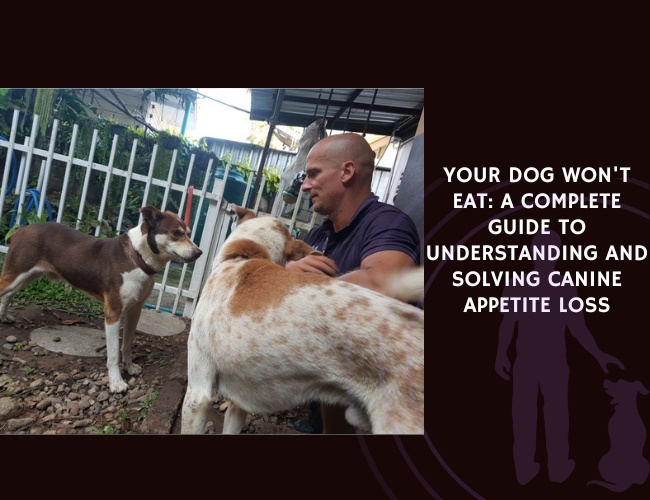Introduction
Step into the world of Alaskan Malamute nutrition, where ancient Arctic heritage meets modern dietary science. These magnificent giants, bred for pulling heavy sleds across frozen tundras, carry unique nutritional needs that reflect their remarkable history. Did you know that your Malamute’s metabolism differs significantly from other breeds, shaped by thousands of years of adaptation to harsh Arctic conditions?
As we guide you through the intricacies of feeding these gentle giants, you’ll discover how proper nutrition can unlock your furry friend’s full potential—from their lustrous double coat to their impressive strength and endurance. Whether you’re welcoming your first Malamute puppy or seeking to optimize your senior companion’s diet, understanding their specific nutritional requirements is the cornerstone of a long, healthy, and joyful life together. 🧡
Breed-Specific Metabolism & Digestive Traits
Understanding Your Malamute’s Unique Engine
Your Alaskan Malamute possesses a metabolic system that tells a story of survival and adaptation. Unlike smaller breeds that burn through calories quickly, these Arctic athletes have evolved with a surprisingly efficient metabolism—a trait that once helped their ancestors survive on limited food during long journeys across frozen landscapes.
Metabolic Efficiency: A Double-Edged Sword
You might notice your Malamute seems to gain weight more easily than expected. This isn’t your imagination—their lower basal metabolic rate means they require fewer calories per pound than many other breeds. Think of it as driving a fuel-efficient truck: impressive for long hauls, but easy to overfill the tank. This efficiency, while remarkable, means you’ll need to be particularly mindful of portion sizes and treat frequency.
The Large Stomach Advantage (and Risk)
Your Malamute’s digestive system features a notably large stomach capacity—a trait that allowed their ancestors to consume large meals when food was available. However, this same characteristic puts them at higher risk for gastric dilatation-volvulus (GDV), commonly known as bloat. This means that how you feed is just as important as what you feed.
Feeding Frequency: Finding the Sweet Spot
While your Malamute can technically handle larger, less frequent meals, we recommend dividing their daily food into two or three smaller portions. This approach helps reduce bloat risk while maintaining steady energy levels throughout the day. You’ll find that most Malamutes thrive on a consistent feeding schedule—their internal clock is remarkably precise! 🐾
Macronutrient Requirements
Building Blocks for Your Arctic Athlete
Let’s explore the three pillars of your Malamute’s nutrition: protein, fat, and carbohydrates. Each plays a crucial role in maintaining their impressive physique and supporting their active lifestyle.
Protein: The Muscle Maintainer
Your Malamute’s protein needs change throughout their life journey:
- Puppyhood Power (22-26% dry matter): During those adorable yet chaotic puppy months, your growing giant needs higher protein levels to support rapid muscle and bone development. You’ll notice how quickly they transform from fluffy bundles into strong adolescents!
- Adult Maintenance (18-22% dry matter): Once fully grown, your Malamute requires quality protein to maintain their impressive muscle mass. Look for foods listing real meat as the first ingredient—your dog’s body recognizes and utilizes these proteins most efficiently.
- Senior Support (up to 24% dry matter): As your faithful companion enters their golden years, slightly higher protein levels help combat age-related muscle loss. However, this increase requires careful monitoring to ensure kidney health remains optimal.
Fat: The Energy Powerhouse
Fat isn’t just about energy—it’s about vitality. Your Malamute typically thrives on diets containing 15-20% fat, but the quality matters immensely:
- Omega-3 Fatty Acids: These inflammation fighters support everything from joint health to that gorgeous double coat. You might notice improved coat shine within weeks of optimizing omega-3 intake!
- Omega-6 Balance: While important, too much omega-6 relative to omega-3 can promote inflammation. The ideal ratio hovers around 5:1 to 10:1 (omega-6 to omega-3).
Carbohydrates: The Sustained Energy Source
Despite some controversy around grains, your Malamute can efficiently utilize quality carbohydrates. The key lies in choosing complex carbs that provide steady energy without blood sugar spikes:
- Sweet potatoes, brown rice, and oats offer sustained energy
- Avoid high-glycemic ingredients that can contribute to weight gain
- Remember: carbohydrates aren’t essential, but they can be beneficial when chosen wisely
Micronutrient Profile
The Hidden Heroes of Health
While macronutrients grab the spotlight, micronutrients work behind the scenes to keep your Malamute thriving. These vitamins and minerals might be needed in smaller amounts, but their impact is mighty.
Essential Vitamins: Your Malamute’s Wellness Warriors
- Vitamin A: Supports those expressive eyes and robust immune system. You’ll find this in quality commercial foods, often derived from liver or fish oils.
- Vitamin D: The “sunshine vitamin” helps your Malamute absorb calcium efficiently. This becomes especially important during those long winter months when outdoor time might be limited.
- Vitamin E: This antioxidant powerhouse protects cells from damage and supports immune function. It works hand-in-hand with selenium for maximum benefit.
- B-Complex Vitamins: These energy metabolizers keep your Malamute’s engine running smoothly. They’re water-soluble, meaning excess amounts are safely excreted—but consistent intake is crucial.
Mineral Balance: The Foundation of Strength
The mineral needs of your Malamute require careful orchestration:
- Calcium and Phosphorus: These partners in bone health must maintain a delicate balance (ideally 1.2:1 to 1.5:1). Too much calcium during puppyhood can actually cause skeletal problems—surprising, isn’t it?
- Zinc: Particularly important for Malamutes, zinc supports immune function and wound healing. Some individuals may have higher requirements, manifesting as skin issues when deficient.
- Selenium: Working alongside Vitamin E, this trace mineral provides antioxidant protection. The amount needed is tiny, but the impact is significant.
Common Food Sensitivities & Intolerances
When Diet Becomes Detective Work
Just like humans, your Malamute can develop food sensitivities that turn mealtime into a mystery. Understanding these potential issues helps you become a better advocate for your furry friend’s health.
Recognizing the Signs
Food sensitivities in Malamutes often manifest in ways you might not immediately connect to diet:
- Persistent ear infections or head shaking
- Excessive paw licking or chewing
- Recurring hot spots or skin irritation
- Loose stools or frequent digestive upset
- Lackluster coat despite proper grooming
Common Culprits
While every Malamute is unique, certain ingredients tend to cause more issues:
- Protein Sources: Beef, chicken, and dairy top the list of common allergens. You might notice your dog doing perfectly on salmon but struggling with chicken—it’s all about individual sensitivity.
- Grain Considerations: Despite popular belief, true grain allergies are relatively rare. However, some Malamutes do better on grain-free diets, possibly due to other ingredients commonly found alongside grains.
- Hidden Triggers: Sometimes it’s not the main protein but additives, preservatives, or even storage mites in kibble that cause reactions.
The Elimination Diet Journey
If you suspect food sensitivities, an elimination diet becomes your roadmap to answers. This process requires patience—typically 8-12 weeks—but the results can be life-changing for your companion. Work closely with your veterinarian to ensure nutritional needs are met during this diagnostic phase. 🧡

Life Stage Nutritional Adjustments
Growing, Thriving, and Aging Gracefully
Your Malamute’s nutritional journey is a dynamic one, with each life stage bringing unique requirements and considerations. Let’s explore how to support your companion through every chapter of their story.
Puppyhood: Building the Foundation (0-18 months)
Those adorable Malamute puppies grow at an astounding rate—but bigger isn’t always better! Controlled growth is crucial for preventing skeletal issues later in life:
- Calorie Control: Resist the urge to overfeed. A slightly lean puppy grows into a healthier adult than an overweight one.
- Calcium Caution: Large breed puppy formulas contain controlled calcium levels for good reason. Excess calcium can cause serious developmental problems.
- Meal Frequency: Young puppies (8-16 weeks) benefit from 3-4 meals daily, gradually transitioning to 2-3 meals as they mature.
- The Growth Curve: Your puppy should feel sleek, not plump. You should easily feel (but not see) their ribs.
Adulthood: Maintaining Peak Performance (18 months – 7 years)
Your adult Malamute has reached their full glory—now it’s about maintaining that impressive physique:
- Activity-Based Adjustments: A couch-potato Malamute needs significantly fewer calories than one who joins you on daily hikes. Adjust portions based on lifestyle.
- Seasonal Considerations: Many Malamutes naturally eat less during warmer months. Trust their instincts while monitoring body condition.
- Treat Mathematics: Those puppy-dog eyes are powerful! Remember that treats should comprise no more than 10% of daily caloric intake.
Senior Years: Supporting Graceful Aging (7+ years)
As your faithful friend enters their golden years, nutritional support becomes even more crucial:
- Protein Preservation: Higher quality (not necessarily higher quantity) protein helps maintain muscle mass as metabolism slows.
- Joint Support: Glucosamine, chondroitin, and omega-3 fatty acids can help those aging joints stay comfortable.
- Digestive Comfort: Some seniors benefit from more easily digestible proteins and added probiotics.
- Cognitive Support: Antioxidants and medium-chain triglycerides may help keep that sharp Malamute mind engaged.
Special Circumstances: Reproductive Nutrition
If you’re blessed with a pregnant or nursing Malamute, her nutritional needs skyrocket:
- Pregnancy: Caloric needs increase by 25-50% during the final trimester
- Lactation: Nursing mothers may need 2-4 times their normal caloric intake
- Quality Over Quantity: Focus on nutrient-dense foods rather than simply increasing volume
Breed-Specific Health Risks with Nutritional Relevance
Preventing Problems Through Proper Nutrition
Your Malamute’s diet plays a crucial role in preventing or managing several breed-specific health concerns. Understanding these connections empowers you to make informed feeding decisions.
Hip Dysplasia: The Weight Connection
This common orthopedic issue in large breeds has a strong nutritional component:
- Puppy Prevention: Controlled growth during puppyhood significantly reduces hip dysplasia risk. Fast growth doesn’t mean healthy growth!
- Weight Management: Every extra pound puts additional stress on those hip joints. Maintaining ideal body weight is one of the most effective preventive measures.
- Anti-Inflammatory Support: Omega-3 fatty acids can help reduce joint inflammation throughout life.
Bloat (GDV): A Life-Threatening Emergency
This condition strikes fear in every large-breed owner’s heart—and rightfully so. Nutritional management can significantly reduce risk:
- Feeding Strategy: Multiple smaller meals reduce stomach distension
- The Exercise Rule: No vigorous activity for at least an hour before and after meals
- Slow It Down: Puzzle feeders or slow-feed bowls prevent rapid gulping
- Food Type Matters: Some research suggests dry kibble soaked in water may reduce risk
Pancreatitis: The Fat Factor
Your Malamute’s pancreas can become inflamed when overwhelmed by dietary fat:
- Moderation is Key: Stick to moderate fat levels (15-20%) in regular diet
- Holiday Hazards: Those turkey drippings might smell amazing to your Malamute, but they’re a pancreatitis risk
- Gradual Changes: Sudden dietary shifts can trigger pancreatic inflammation
Dilated Cardiomyopathy (DCM): An Emerging Concern
Recent research has raised questions about diet and heart health:
- Taurine Connection: Ensure adequate taurine through diet or supplementation
- Grain-Free Debate: Work with your veterinarian to weigh the risks and benefits
- Regular Monitoring: Annual cardiac screening can catch issues early
Powerful. Primal. Precise.
Feeding a Malamute is fuelling a legacy.
Behind those soulful eyes lies a metabolism forged in Arctic extremes—efficient, enduring, and easily overfilled. Your gentle giant doesn’t eat like other breeds, because it wasn’t built like other breeds.
Nutrition is protection disguised as routine.
From joint strength to bloat prevention, every portion, ingredient, and schedule shapes your Malamute’s future. Overfeeding, underbalancing, or feeding too fast can spark avoidable risks in a dog built for survival, not indulgence.
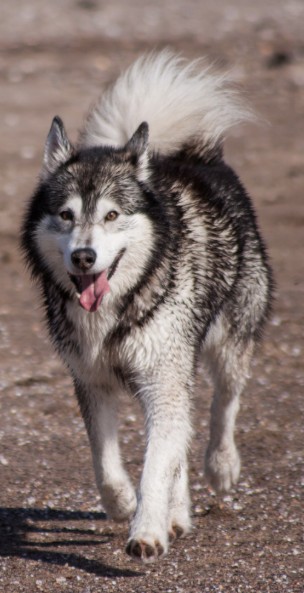
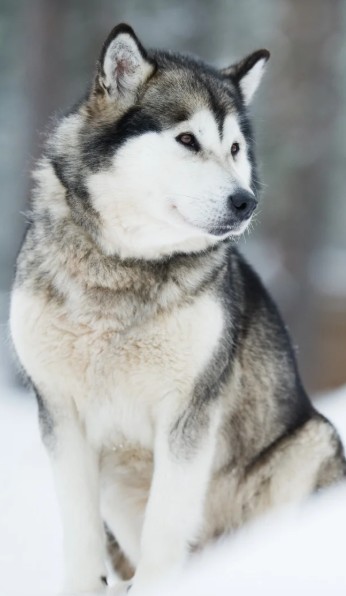
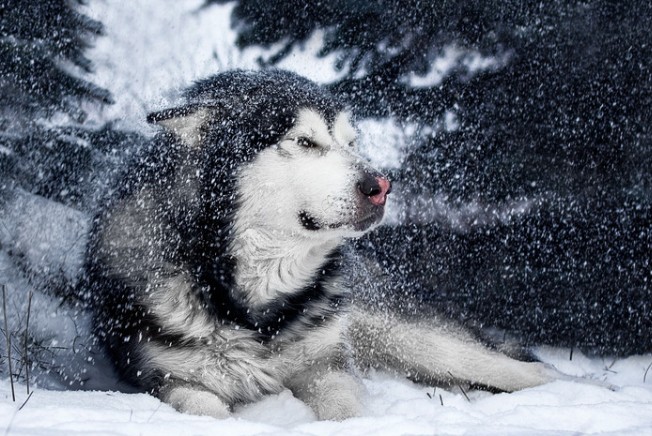
Greatness thrives on awareness, not assumption.
Coat shine, digestion, stamina, and mood all echo your choices. When you feed your Malamute with science, structure, and seasonal intuition, you’re not just nourishing a body—you’re honouring an ancestral bond.
Recommended Feeding Methods & Diet Types
Finding Your Malamute’s Perfect Menu
The world of dog nutrition offers numerous options, each with passionate advocates. Let’s explore what works best for Malamutes, helping you make an informed decision for your furry friend.
Commercial Kibble: The Convenient Choice
High-quality kibble remains the most popular choice for good reason:
- Pros: Balanced nutrition, convenience, dental benefits, long shelf life
- Cons: Processing may reduce some nutrients, quality varies dramatically between brands
- Malamute Considerations: Choose large-breed formulas with glucosamine for joint support
- Reading Labels: First ingredient should be named meat, avoid by-products and fillers
Raw Food Diets: Back to Nature?
The raw feeding movement has gained traction among Malamute owners:
- Potential Benefits: Improved coat quality, smaller stools, increased enthusiasm for meals
- Significant Risks: Bacterial contamination, nutritional imbalances if not properly formulated
- The Reality Check: Requires significant time, freezer space, and expertise
- Veterinary Guidance: Essential for safe implementation
Home-Cooked Diets: Made with Love
Some owners prefer preparing their Malamute’s meals personally:
- The Appeal: Complete control over ingredients, can accommodate specific sensitivities
- The Challenge: Achieving nutritional balance requires expertise
- Professional Help: Veterinary nutritionist consultation is strongly recommended
- Time Investment: Considerable preparation and planning required
Combination Approaches: Best of Both Worlds?
Many Malamute owners find success mixing methods:
- Base diet of high-quality kibble with raw or cooked toppers
- Rotating between different protein sources
- Seasonal adjustments (more calories in winter, lighter fare in summer)
Supplement Strategies
Even the best diet might benefit from targeted supplementation:
- Joint Support: Glucosamine and chondroitin for those hardworking joints
- Omega-3 Boost: Fish oil for coat health and inflammation control
- Probiotics: Supporting digestive health, especially during dietary transitions
- Multivitamins: Only if recommended by your veterinarian—more isn’t always better!
Practical Feeding Guidelines for Malamute Owners
From Theory to Practice: Real-World Feeding Success
Now let’s transform all this knowledge into practical, everyday strategies that work for real Malamute owners facing real challenges.
Addressing Food-Related Behaviors
Food Guarding: The Resource Protection Instinct
Your Malamute’s ancestors needed to protect their food to survive. If your dog shows guarding behaviors:
- Work with a professional trainer using positive reinforcement
- Practice “trading” exercises—offering something better in exchange
- Feed in a quiet, secure location to reduce anxiety
- Never punish guarding—it often makes the behavior worse
The Speed Eater Dilemma
Many Malamutes inhale their food as if it might disappear. This isn’t just messy—it’s dangerous:
- Slow-Feed Solutions: Puzzle bowls can turn a 30-second meal into a 10-minute engagement
- The Muffin Tin Trick: Spreading kibble across a muffin tin naturally slows consumption
- Food Dispensing Toys: Make mealtime mentally stimulating while controlling pace
- The Tennis Ball Method: Simply placing a clean tennis ball in the bowl forces slower eating
Dealing with Picky Eaters
Yes, some Malamutes can be selective! If your usually enthusiastic eater becomes finicky:
- Rule out medical issues first—sudden appetite changes warrant veterinary attention
- Avoid the “buffet trap” of constantly offering new foods
- Set meal times—food down for 15 minutes, then removed
- Sometimes a bit of warm water or low-sodium broth rekindles interest
Transitioning Foods Successfully
Malamutes can have sensitive stomachs when it comes to dietary changes:
- The 7-10 Day Rule: Gradually mix new food with old, increasing proportions slowly
- Watch for Signs: Loose stools, gas, or vomiting indicate you’re moving too fast
- The 25% Formula: Days 1-2: 75% old, 25% new; Days 3-4: 50/50; Days 5-6: 25% old, 75% new
- Individual Variation: Some Malamutes need even slower transitions
Creating the Optimal Feeding Environment
Your Malamute’s eating space affects their dining experience:
- Elevated Feeders: Controversial for bloat risk—consult your vet
- Non-Slip Surfaces: Prevents bowl sliding and reduces neck strain
- Quiet Zones: Away from high-traffic areas to reduce stress
- Separate Spaces: Multi-dog households may need individual feeding areas

Monitoring & Adjusting: Your Ongoing Journey
Becoming Your Malamute’s Nutritional Detective
Successful Malamute nutrition isn’t “set it and forget it”—it’s an ongoing conversation between you and your dog’s changing needs.
Body Condition Scoring: Your Most Important Tool
Learn to assess your Malamute’s body condition:
- The Rib Test: You should feel ribs easily but not see them
- The Waist Check: Looking from above, a visible waist indicates good condition
- The Profile View: A slight tuck-up from chest to hind legs is ideal
- Regular Weigh-Ins: Monthly weight checks catch trends early
Seasonal Adjustments
Your Malamute’s needs fluctuate with the seasons:
- Winter Increase: Many Malamutes need 10-20% more calories in cold weather
- Summer Decrease: Reduced activity in heat means fewer calories needed
- Coat Cycles: Increased protein during major shedding seasons supports coat health
- Hydration Focus: Summer requires special attention to water intake
Age-Related Modifications
As your Malamute ages, stay alert for needed changes:
- Decreased appetite might indicate dental issues
- Increased thirst could signal kidney concerns
- Weight gain often creeps up as activity decreases
- Digestive sensitivities may develop with age
Special Considerations & Expert Tips
Wisdom from the Malamute Community
Years of collective experience from Malamute owners and professionals offer these invaluable insights:
The Working Malamute’s Needs
If your Malamute actively pulls sleds, carts, or participates in weight pulling:
- Caloric needs may double or triple during work seasons
- Protein requirements increase to support muscle recovery
- Electrolyte balance becomes crucial
- Post-exercise nutrition timing affects recovery
Climate Considerations
Your location significantly impacts nutritional needs:
- Cold Climates: Higher fat content supports temperature regulation
- Warm Climates: Lower caloric density prevents overheating
- Humid Conditions: Increased attention to hydration and electrolyte balance
- Altitude: May affect appetite and hydration needs
The Multi-Malamute Household
Feeding multiple Malamutes presents unique challenges:
- Individual needs may vary dramatically despite similar size
- Competition can lead to rapid eating or resource guarding
- Separate feeding stations prevent conflicts
- Monitor each dog’s consumption carefully
Troubleshooting Common Nutritional Challenges
When Things Don’t Go According to Plan
Even with the best intentions, nutritional challenges arise. Here’s how to handle common issues:
The Constantly Hungry Malamute
If your Malamute acts perpetually starved:
- Verify you’re feeding appropriate amounts for their activity level
- Check for parasites or underlying health issues
- Consider foods with higher fiber content for satiety
- Implement puzzle feeders to extend meal satisfaction
Recurring Digestive Upset
Chronic stomach issues require investigation:
- Keep a detailed food diary including treats and table scraps
- Consider food sensitivity testing
- Explore probiotic supplementation
- Gradually increase fiber content
The Overweight Malamute
Extra pounds are easier to prevent than lose:
- Reduce portions by 10-20% initially
- Increase exercise gradually to prevent injury
- Replace high-calorie treats with vegetables
- Involve all family members in the weight loss plan
Looking Forward: The Future of Malamute Nutrition
Emerging Trends and Ongoing Research
The field of canine nutrition continues evolving, with several areas particularly relevant to Malamutes:
Personalized Nutrition
Genetic testing and microbiome analysis may soon allow truly individualized diet plans tailored to your specific Malamute’s needs.
Sustainable Protein Sources
As environmental consciousness grows, alternative proteins like insect-based foods may become viable options for our Arctic giants.
Functional Foods
Foods designed to address specific health concerns—from cognitive support to joint health—continue advancing.
Technology Integration
Smart feeders and apps help monitor intake and adjust portions automatically, perfect for maintaining your Malamute’s ideal weight.
Conclusion: Your Malamute’s Nutritional Journey
As we reach the end of this comprehensive guide, remember that feeding your Alaskan Malamute is both a science and an art. These magnificent dogs, with their rich heritage and unique physiological traits, deserve our thoughtful attention to their nutritional needs.
You’ve learned how their efficient metabolism can be both a blessing and a challenge, requiring careful portion control to prevent obesity. You understand the critical balance of proteins, fats, and carbohydrates needed at each life stage. Most importantly, you’ve discovered how proper nutrition can prevent or manage breed-specific health concerns, from hip dysplasia to the dreaded bloat.
Whether you choose commercial kibble, explore raw feeding, or craft home-cooked meals, the key is understanding your individual Malamute’s needs. Watch for their signals, monitor their body condition, and never hesitate to consult with veterinary professionals when questions arise.
Is the Alaskan Malamute’s nutritional needs more complex than some breeds? Perhaps. But for those of us who share our lives with these gentle giants, the reward of seeing them thrive—coat gleaming, eyes bright, ready for the next adventure—makes every moment of careful meal planning worthwhile.
Your Malamute depends on you to make the best nutritional choices for their health and happiness. Armed with this knowledge, you’re ready to provide the foundation for a long, healthy, and joyful life together. After all, proper nutrition isn’t just about feeding your Malamute—it’s about fueling the incredible bond you share. 🐾🧡

